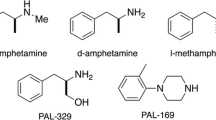Abstract
The effects of various psychomotor stimulant drugs and drugs outside this class were examined on the efficacy of stimuli previously paired with reinforcement or reward (conditioned reinforcers, CR) in controlling responding. Pipradrol (5–45 μmol/kg), d-amphetamine (1.25–15.0 μmol/kg), and the cocaine analogues WIN 35,428 (0.1–30.0 μmol/kg) and in one of two determinations WIN 35,065-2 (0.1–29.0 μmol/kg) all generally increased responding on a lever providing CR, but did not change or decreased responding on a lever providing no CR (NCR). Cocaine (5–125 μmol/kg) and chlordiazepoxide (3.75–60.0 μmol/kg) had no significant effects. Morphine (3.2–32.0 μmol/kg) and α-flupenthixol (0.02–2.0 μmol/kg) generally reduced responding on both levers. Apomorphine (0.1–1.0 μmol/kg) generally increased responding on both levers. Neurochemical data showed that d-amphetamine was generally more potent than pipradrol in its effects on in vitro monoamine uptake and release.
Similar content being viewed by others
References
Beninger RJ, Hanson DR, Phillips AG (1980) The effects of pipradrol on the acquisition of responding with conditioned reinforcement: A role for sensory preconditioning. Psychopharmacology 69:235–242
Beninger RJ, Hanson DR, Phillips AG (1981) The acquisition of responding with conditioned reinforcement: Effects of cocaine (+)-amphetamine and pipradrol. Br J Pharmacol 74:149–154
Brown BB, Werner HW (1954) Pharmacological studies on a central stimulant: 1-(2-piperidyl)-benzhydrol hydrochloride (MRD-108). J Pharmacol Exp Ther 110:180–187
Butcher LL (1968) Effects of apomorphine on free-operant avoidance behaviour in the rat. Eur J Pharmacol 3:163–166
Crow TJ (1976) Specific monoamine systems as reward pathways: Evidence for the hypothesis that activation of the ventral mesencephalic dopaminergic neurones and noradrenergic neurones of the locus coeruleus complex will support self-stimulation responding. In: Wauquier A, Rolls ET (eds) Brain stimulation reward. North Holland-Elsevier, Amsterdam, pp 211–235
D'Mello GD, Goldberg DM, Goldberg SR, Stolerman IP (1981) Conditioned taste aversion and operant behavior in rats: Effects of cocaine, apomorphine and some long-lasting derivatives. J Pharmacol Exp Ther 219:60–68
Ennis C, Kemp JD, Cox B (1981) Characterisation of inhibitory 5-hydroxytryptamine receptors that modulate dopamine release in the striatum. J Neurochem 36:1515–1520
Ferris RM, Tang FLM, Maxwell RA (1972) A comparison of the capacities of isomers of amphetamine, deoxypipradrol and methylphenidate to inhibit the uptake of triatiated catecholamines into rat cerebral cortex slices, synaptosomal preparations of rat cortex, hypothalamus and striatum and into adrenergic nerves of rabbit aorta. J Pharmacol Exp Ther 181:407–416
Fog R (1969) Stereotyped and non-stereotyped behaviour in rats induced by various stimulant drugs. Psychopharmacologia 14:299–304
Gray EG, Whittaker VP (1962) The isolation of nerve endings from brain: An electron microscope study of cell fragments derived by homogenisation and centrifugation. J Anat 96:79–87
Gray JA (1977) Drug effects on fear and frustration: Possible limbic site of action of minor tranquilizers. In: Iversen LL, Iversen SD, Snyder SH (eds) Handbook of psychopharmacology, vol 8. Plenum, New York, pp 433–529
Heikkila RE, Cabbat FA, Manzino L, Duvoisin RC (1979) Rotational behavior induced by cocaine analogues in rats with unilateral 6-hydroxydopamine lesions of the substantia nigra. J Pharmacol Exp Ther 211:189–194
Herberg LJ, Stephens DN, Franklin KBJ (1976) Catecholamines and self-stimulation: Evidence suggesting a reinforcing role for noradrenaline and a motivating role for dopamine. Pharmacol Biochem Behav 4:575–582
Hill RT (1970) Facilitation of conditioned reinforcement as a mechanism of psychomotor stimulation. In: Costa E, Garattini S (eds) Amphetamines and related compounds. Raven, New York, pp 781–795
MacPhail RC, Seiden LS (1975) Time course for the effects of cocaine on fixed-ratio water responding in rats. Psychopharmacologia 44:1–4
Moore KE (1978) Amphetamines: Biochemical and behavioural actions in animals. In: Iversen LL, Iversen SD, Snyder SH (eds) Handbook of psychopharmacology, vol 11. Plenum, New York, pp 41–98
deOliviera L, Graeff FG (1972) Comparison between the effects of apormorphine and amphetamine on operant behaviour. Eur J Pharmacol 18:159–165
Ridley RM, Baker HF, Haystead TAJ (1981) Perseverative behaviour after amphetamine: Dissociation of response tendency from reward association. Psychopharmacology 75:283–286
Robbins TW (1976) Relationship between reward-enhancing and stereotypical effects of psychomotor stimulant drugs. Nature 264:57–59
Robbins TW (1978) The acquisition of responding with conditioned reinforcement: Effects of pipradrol, methylphenidate, d-amphetamine, and nomifensine. Psychopharmacology 58:79–87
Robbins TW, Koob GF (1978) Pipradrol enhances reinforcing properties of stimuli paired with brain stimulation. Pharmacol Biochem Behav 8:219–222
Robbins TW, Everitt BJ (1982) Functional studies of the central catecholamines. Int Rev Neurobiol 23:303–365
Scheel-Krüger J (1971) Comparative studies of various amphetamine analogues demonstrating different interactions with the metabolism of the catecholamines in the brain. Eur J Pharmacol 14:47–59
Spealman RD, Goldberg SR, Kelleher RT, Goldberg DM, Charlton JP (1977) Some effects of cocaine and two cocaine analogues on schedule-controlled behavior of squirrel monkeys. J Pharmacol Exp Ther 202:500–509
Von Voigtlander PF, Moore KE (1973) Involvement of nigrostriatal neurons in the in vivo release of dopamine by amphetamines, amantadine and tyramine. J Pharmacol Exp Ther 184:542–552
White TD, Keen P (1970) The role of internal and external Na+ and K+ on the uptake of 3H-noradrenaline by synaptosomes prepared from rat brain. Biochem Biophys Acta 196:285–295
Winer BJ (1971) Statistical principles in experimental design. McGraw Hill-Kogakusha, Tokyo
Author information
Authors and Affiliations
Rights and permissions
About this article
Cite this article
Robbins, T.W., Watson, B.A., Gaskin, M. et al. Contrasting interactions of pipradrol, d-amphetamine, cocaine, cocaine analogues, apomorphine and other drugs with conditioned reinforcement. Psychopharmacology 80, 113–119 (1983). https://doi.org/10.1007/BF00427952
Received:
Accepted:
Issue Date:
DOI: https://doi.org/10.1007/BF00427952




